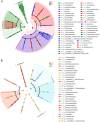Dynamic responses of gut microbiota to agricultural and wildfire ash: insights from different amphibian developmental stages
- PMID: 40881301
- PMCID: PMC12380842
- DOI: 10.3389/fmicb.2025.1598446
Dynamic responses of gut microbiota to agricultural and wildfire ash: insights from different amphibian developmental stages
Abstract
Combustion by-products-specifically wildfire ash and rice-straw ash-are emerging contaminants in freshwater ecosystems. However, their impacts on amphibian survival and gut microbiota across various developmental stages remains largely unclear, thereby limiting evidence-based conservation strategies in fire-affected habitats. This study evaluated the effects of artificial water (control, C) and aqueous extracts of ash (AEAs) derived from wildfire ash (W) and rice straw ash (S) on the survival and gut (G) microbiota of Rana dybowskii tadpoles (T) and adult frogs (F). Exposure to wildfire ash significantly reduced tadpole survival compared to rice straw ash, whereas no significant differences were observed in adult frogs. Alpha diversity of the gut microbiota differed significantly among tadpole groups but not among adult groups. Bray-Curtis and weighted UniFrac analyses revealed significant differences in the gut microbiota of adult frogs and tadpoles across different treatment groups. Linear discriminant analysis effect size (LEfSe) identified a significant enrichment of specific bacterial genera across treatment groups. BugBase analysis indicated that in the TCG, TSG, and TWG groups, notable variations in the TCG, TSG, and TWG groups, there were notable differences in Forms-Biofilms and Potentially-Pathogenic, while in the FCG, FSG, and FWG groups, significant differences were observed in Aerobic, Gram-Positive, Potentially-Pathogenic, and Stress-Tolerant. These findings suggest that wildfire ash exhibits greater toxicity than rice straw ash to both life stages of R. dybowskii, with tadpoles being more vulnerable. By elucidating the link between ash-derived pollutants and amphibian gut health, this study underscores the growing threat of routine straw burning and intensifying wildfires to global freshwater biodiversity and advocates for ash-specific mitigation measures and microbiota-informed conservation strategies.
Keywords: Rana dybowskii; gut microbiota; rice straw; survival; wildfire ash.
Copyright © 2025 Tong, Xu, Fan, Pan, Long, Dong, Cui and Luo.
Conflict of interest statement
The authors declare that the research was conducted in the absence of any commercial or financial relationships that could be construed as a potential conflict of interest.
Figures





Similar articles
-
Exposure to Rice Straw Ash Alters Survival, Development and Microbial Diversity in Amphibian Tadpoles.Ecol Evol. 2025 Jul 25;15(7):e71801. doi: 10.1002/ece3.71801. eCollection 2025 Jul. Ecol Evol. 2025. PMID: 40718695 Free PMC article.
-
Differential impact of wildfire and rice straw ash on the skin microbiota of Rana dybowskii adults and tadpoles.Environ Pollut. 2025 Feb 1;366:125470. doi: 10.1016/j.envpol.2024.125470. Epub 2024 Dec 6. Environ Pollut. 2025. PMID: 39647769
-
Effects of parental care on skin microbial community composition in poison frogs.Elife. 2025 Jul 31;14:RP103331. doi: 10.7554/eLife.103331. Elife. 2025. PMID: 40742751 Free PMC article.
-
Intravenous magnesium sulphate and sotalol for prevention of atrial fibrillation after coronary artery bypass surgery: a systematic review and economic evaluation.Health Technol Assess. 2008 Jun;12(28):iii-iv, ix-95. doi: 10.3310/hta12280. Health Technol Assess. 2008. PMID: 18547499
-
Home treatment for mental health problems: a systematic review.Health Technol Assess. 2001;5(15):1-139. doi: 10.3310/hta5150. Health Technol Assess. 2001. PMID: 11532236
References
-
- Abu-Elala N. M., Hossam-Elden N., Marzouk M. S., El Basuini M. F. (2025). Chitosan for aquaculture: growth promotion, immune modulation, antimicrobial activity, bio-carrier utility, water quality management, and safety considerations–a review. Ann. Anim. Sci. 25, 483–509. 10.2478/aoas-2024-0079 - DOI
-
- Anih L. N., Atama C. I., Chiejina C. O., Ezeani S. I., Chinwe Ezinwa H., Chukwu M. N., et al. (2024). Long term integrated biomarker responses in freshwater African catfish Clarias gariepinus exposed to a new brand of herbicide fluazifop-p-butyl. Drug Chem. Toxicol. 47, 42–54. 10.1080/01480545.2023.2174987 - DOI - PubMed
-
- Bodí M. B., Martin D. A., Balfour V. N., Santín C., Doerr S. H., Pereira P., et al. (2014). Wildland fire ash: production, composition and eco-hydro-geomorphic effects. Earth Sci. Rev. 130, 103–127. 10.1016/j.earscirev.2013.12.007 - DOI
-
- Brooks G. C., Kindsvater H. K. (2022). Early development drives variation in amphibian vulnerability to global change. Front. Ecol. Evol. 10:813414. 10.3389/fevo.2022.813414 - DOI
LinkOut - more resources
Full Text Sources
Research Materials
Miscellaneous

